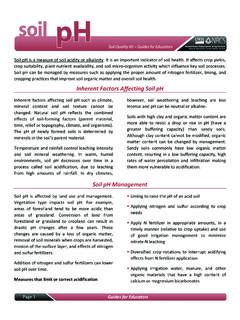Transcription of Louisiana Vegetable Planting Guide - LSU AgCenter
1 Louisiana Vegetable Planting Guide 1. Louisiana Vegetable Planting Guide Vegetable gardening is a favorite pastime for Louisiana should plant about two weeks later than many individuals and families. Homegrown vegetables the earliest dates given and north Louisiana about are better because they are fresher and have higher four weeks later. For example, snap beans may be nutrient value since they are harvested closer to planted on February 15 in New Orleans, but around their peak ripeness. Homegrown vegetables usually March 1 in Alexandria and about March 15 in Shreve- cost less than if they were bought in the store. port or Monroe area. Generally, with the spring Gardening provides a means of exercise, recre- vegetables, the first Planting should be made after the ation, therapy and an opportunity for many to expe- danger of frost is over.
2 Rience a closeness to nature. Statements such as Let seed or Plants 100 ft. of row The amount me show you my garden or I grew that, give a of seed given here is the minimum amount required sense of self-satisfaction on which a monetary value to plant 100 feet of row. cannot be placed. Depth to Plant seed This will depend upon Gardens may range in size from a single pot- the seed size and soil type. Small seeded crops are ted tomato plant to a large family or truck garden. planted shallow and larger seed crops are planted However, remember to make your garden just large deeper. Heavy (clay) soils require a more shallow enough so that it will meet your needs but will not depth of Planting than do lighter (sandy) soils. If become a burden to care for.
3 Irrigation water is not available and the soil is dry, Plan ahead. Locate the garden in as sunny a your seed may have to be planted a little deeper than location as possible. The fruit-bearing crops, such as normal. tomatoes, peppers and squash, need full sunlight for Space Between Plants Correct spacing best production. Too much shade results in a very between and within rows is important to allow for disappointed gardener because of limited produc- proper growth, cultivation and efficient use of space. tion. However, the leafy vegetables will tolerate more Leaving plants spaced too close will result in poor, shade than the root or fruit-bearing crops. weak growth and lower yields. It is a common prac- In Louisiana , something can be planted every tice to sow seed thickly and then thin to the proper day of the year, so make use of all the garden space spacing.
4 Year-round. As soon as one crop is through bearing, Rows are spaced 3 to 31/2 feet apart. For water- pull it out, rework the row and plant something else. melon, pumpkin and cantaloupes, plant every other For example, after Irish potatoes are dug in May or row. June, rework the row and plant peas, okra or sweet For intensive culture or wide row' gardening use potatoes. Successive plantings made a week or two the larger in row' spacing and allow enough room apart provide a means of having a continuous fresh between rows so that when the plants are mature, supply of certain vegetables such as bush snap beans, they will barely be touching the neighboring row. peas or greens. Also, Planting early, midseason and Remember that yields, quality and pest control will late-maturing varieties at the same time will extend normally be superior if plants are given plenty of your harvest.
5 Of course, some of these practices will room to grow. be limited by available space. This publication should be used by the Vegetable Days to Harvest-The number of days to har- gardener as a Guide to a successful garden. The infor- vest depends on the variety selected, the seasonal mation contained herein has been developed after temperatures, seasonal rainfall, cultural practices and considerable research and practical experience. whether direct seeded or transplanted. The number of days indicated on the chart is an average range The following comments about each item may which can be expected. help you to better understand and use this informa- For the gardener who is interested in the de- tion so that you can get the greatest benefit from it.
6 Tailed culture of a certain crop, gardening hints for Planting date With the spring Planting , the these crops are available from your county agent's southern-most parishes may use the earliest dates office. given for their first plantings. Gardeners in central 2. Cultural Recommendations Planting Dates seed /Plants Depth Inches Days Crop per to between to Spring Fall 100 ft. Plant Plants Harvest Beans, Snap, Bush 2/15 - 5/15 8/10- 9/10 1/2 lb. 1/2 2-3 48-55. Beans, Snap, Pole 2/15 - 5/15 8/10- 8/31 2 oz. 1/2 12 60-66. Beans, Lima, Bush 3/1 - 5/30 8/1 - 9/1 1/2 lb. 1/2 3-4 60-67. Beans, Lima, Pole 3/1 - 5/30 8/1 - 9/1 1/4 lb. 1/2 12 77-90. Beets 1/15 - 2/28 8/15 -10/1 3/4 oz. 1/4 2-4 55-60. Broccoli ( seed ) 1/1 - 1/31 7/15 - 9/1 1/32 oz.
7 1/8 18-24 70-90*. Brussels Sprouts ( seed ) 7/15 - 9/1 1/32 oz. 1/8 12-15 90*. Cabbage 10/1 - 1/30 7/1 - 9/15 1/32 oz. 1/8 12-15 65-75*. Cantaloupes 3/1 - 8/1 1/8 oz. 1/4 18-24 80-85. Carrots 1/15 - 2/15 9/1 -11/1 1/4 oz. 1/8 1-2 70-75. Cauliflower 1/15 - 2/15 7/1 - 9/1 1/16 oz. 1/8 18-24 55-65*. Celery ( seed ) 10/1 -11/1 1/64 oz. 1/8 6-8 210. Chard, Swiss 1/15 - 5/1 8/15 - 10/30 1/2 oz. 1/4 6-8 45-55. Chinese Cabbage 1/15 - 2/15 7/15 - 10/1 1/32 oz. 1/4 12 60-80*. Collards 3/15 -10/1 1/16 oz. 1/8 6-12 75. Corn, Sweet 2/15 - 5/15 3 oz. 1/2 10-12 69-92. Cucumbers 3/1 - 9/1 1/4 oz. 1/4 12-18 50-65. Eggplant ( seed ) 1/15 - 6/1 1/32 oz. 1/8 140. Eggplant (Plants) 3/15 - 7/1 50-60 plts. 18-24 80-85*. Garlic 10/1 -11/30 2 lbs. 1 4-6 210. Kohlrabi 1/1 - 3/30 8/15-10/30 1/16 oz.
8 1/8 6 55-75. Lettuce 1/1 - 1/31 8/15- 9/30 1/32 oz. 1/8 4-12 45-80. Mustard Greens 8/1 - 3/15 1/8 oz. 1/8 1-2 35-50. Okra 3/1 - 8/1 1/2 oz. 1/2 12 60. Onion, Leek ( seed ) 9/20 - 10/15 1/8 oz. 1/8 2-4 135-210. Onion, Leek (Sets) 12/15 - 1/30 300-600 plts. 1 2-4 120-150. Peanuts 4/1 - 6/15 1/2 lb. 1 4-8 110-120. Peas, English 12/15 - 1/31 9/1 - 9/15 2-4 oz. 1/2 2-3 60-70. Peas, Southern 3/1 - 8/10 4-6 oz. 1/2 4-6 70-80. Pepper, Hot ( seed ) 1/15 - 5/1 1/16 oz. 1/8 140. Pepper, Hot (Plants) 3/15 - 6/15 66-100 plts. 12-18 70*. Pepper, Bell ( seed ) 1/15 - 2/28 6/5 - 7/5 1/16 oz. 1/8 140-150. *Days from transplant; plts. = plants 3. Cultural Recommendations Planting Dates seed /Plants Depth Inches Days Crop per to between to Spring Fall 100 ft.
9 Plant Plants Harvest Pepper, Bell (Plants) 3/15 - 5/15 7/15 - 8/15 66-80 plts. 15-18 70-80*. Potatoes, Irish 1/20 - 2/28 8/15 - 9/10 10-12 lbs. 4 12 90-120. Potatoes, Sweet 4/10 - 7/1 100 plts. 12 90-120*. Pumpkin 3/15 - 9/15 1/2 oz. 1/2 36-60 90-120. Radishes 1/15 - 3/31 9/1 -11/1 1 oz. 1/8 1 22-28. Rutabagas 7/1 - 8/31 1/16 oz. 1/8 4-8 88. Shallots 7/1 - 2/28 200-300 plts. 1 4-8 50. Spinach 10/1 - 2/28 1/4 oz. 1/8 3-6 35-45. Summer Squash 3/1 - 8/15 1/2 oz. 1/8 36 50-90. Tomatoes ( seed ) 1/1 - 3/15 6/1 - 7/1 1/64 oz. 1/8 100-115. Tomatoes (Plant) 3/1 - 5/1 7/1 - 8/15 50-66 plts. 16-24 60-75*. Turnips 8/1 - 2/28 1/8 oz. 1/8 2-6 40-50. Watermelons 3/15 - 8/1 1/4 oz. 1/2 48 90-110. *Days from transplant; plts. = plants 4. Recommended Varieties for Louisiana Beans, Lima (Bush) Henderson Bush, Fordhook 242 (AAS), Thorogreen, Jackson Wonder, Dixie Butterpea.
10 Beans, Lima (Pole) Carolina Sieva, Florida Speckled, Willow Leaf, Christmas, King of Garden. Provider, Contender, Blue Lake 274, Royal Burgundy, Strike, Festina, Ambra, Magnum, Golden Rod Beans, Snap (Bush) Wax, Green Crop (flat), Roma II, Bronco, Hialeah, Storm, Derby (AAS),Valentino, Caprice, Dusky Grenable, Lynx, Nash and Shade. Kentucky Blue (AAS), McCaslin, Blue Lake,Volunteer, State, La Purple, Kentucky Wonder 191, Beans, Snap (Pole). Rattlesnake (striped),Yardlong Asparagus Bean. Beets Ruby Queen, Detroit Dark Red, Red Ace, Kestrel, Scarlet Supreme. Windsor, Packman, Green Comet, Gypsy, Premium Crop (AAS), Arcadia, Everest, Patron, Triathalon, Broccoli Diplomat, Greenbelt. Brussels Sprouts Jade Cross E, Long Island Imp., Oliver, Royal Marvel.














